Ductal Carcinoma In Situ
Ductal carcinoma in situ (DCIS) is a non-invasive cancer where abnormal cells have been found in the lining of the breast milk duct. The atypical cells have not spread outside of the ducts into the surrounding breast tissue. Ductal carcinoma in situ is pre cancerous and iscurable, but if it’s left untreated some grades of DCIS may progress to become cancer.
What does the term “in situ” mean?
The earliest stages of cancers are called “carcinoma in situ.” Carcinoma means “cancer” and in situ means “in the original place.”
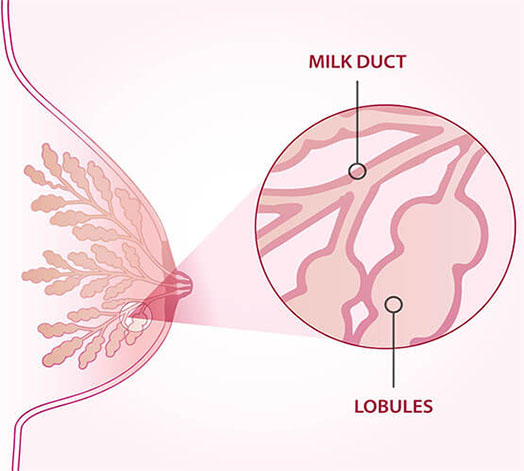
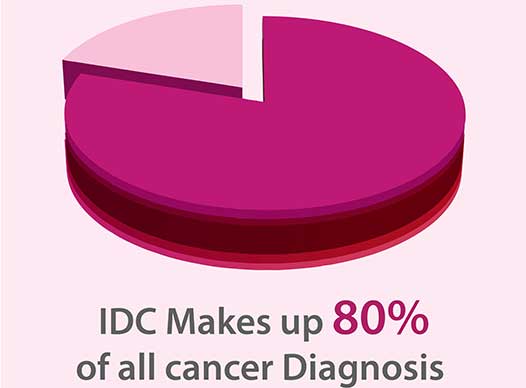
Invasive Ductal Carcinoma (IDC)
The abnormal cancer cells that began forming in the milk ducts have spread beyond the ducts into other parts of the breast tissue. Invasive cancer cells can also spread to other parts of the body. It is also sometimes called infiltrative ductal carcinoma.
- IDC is the most common type of breast cancer, making up nearly 70- 80% of all breast cancer diagnoses.
- IDC is also the type of breast cancer that can most commonly affects men.
WHAT IS THE DIFFERENCE BETWEEN INVASIVE DUCTAL CARCINOMA (IDC) AND DUCTAL CARCINOMA IN SITU (DCIS)?
DCIS means the atypical is still contained in the milk duct and has not invaded any other area. IDC is cancer that began growing in the duct and is invading the surrounding tissue. Cancer staging done by a physician, along with a physical exam and medical history can help identify the best treatment options.
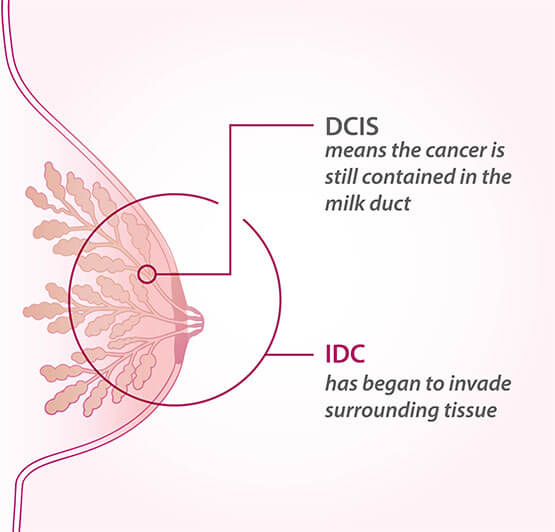
TRIPLE NEGATIVE BREAST CANCER
A diagnosis of triple negative breast cancer means that the three most common types of receptors known to fuel breast cancer growth–estrogen, progesterone, and the HER-2/neu gene– are not present in the tumor. This means that the breast cancer cells have tested negative for hormone epidermal growth factor receptor 2 (HER-2), estrogen receptors (ER), and progesterone receptors (PR). Since the tumor cells lack the necessary receptors, common treatments like hormone therapy and drugs that target estrogen, progesterone, and HER-2 are ineffective. Using chemotherapy to treat triple negative breast cancer is still an effective option. In fact, triple negative breast Is known to respond better to chemotherapy as compared to other cancer subtypes
Risk For Triple Negative Breast Cancer
Triple negative breast cancer occurs in about 10-20% of diagnosed breast cancers and is more likely to affect younger people and/or those with a BRCA1 gene mutation.
Prognosis for triple negative breast cancer
Triple negative breast cancer can be more aggressive and difficult to treat. Also, the cancer is more likely to spread and recur. The stage of breast cancer and the grade of the tumor will influence your prognosis.
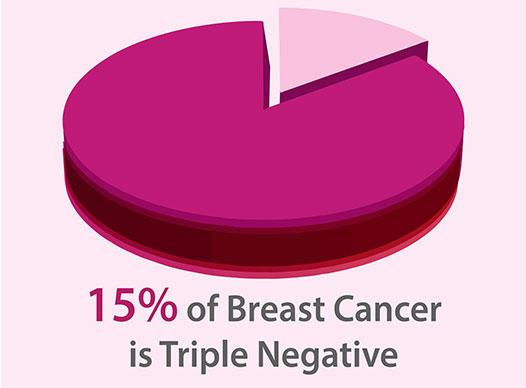
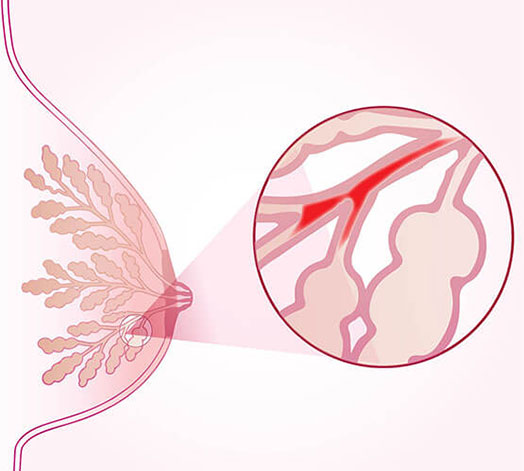
INFLAMMATORY BREAST CANCER (IBC)?
Inflammatory breast cancer is an an aggressive and fast growing breast cancer in which cancer cells infiltrate the skin and lymph vessels of the breast. It often produces no distinct tumor or lump that can be felt and isolated within the breast. But when the lymph vessels become blocked by the breast cancer cells, symptoms begin to appear.
Symptoms Of Inflammatory Breast Cancer?
Early IBC symptoms may include persistent itching and the appearance of a rash or small irritation similar to an insect bite. The breast typically becomes red, swollen, and warm. The skin may appear pitted like an orange peel, and nipple changes such as inversion, flattening, or dimpling may occur.

How Is Inflammatory Breast Cancer Diagnosed And Treated?
A diagnosis of inflammatory breast cancer is classified as Stage 3 breast cancer and is diagnosed through your physician’s clinical judgment and a biopsy. Typically, IBC grows rapidly and requires aggressive treatment. Most oncologists recommend both local treatment of the affected breast and systemic therapy), which includes chemotherapy. With aggressive treatment, the survival rate for inflammatory breast cancer patients has improved significantly in recent years.
METASTATIC BREAST CANCER
Metastatic breast cancer is also classified as Stage 4 breast cancer. The cancer has spread to other parts of the body. This usually includes the lungs, liver, bones or brain.
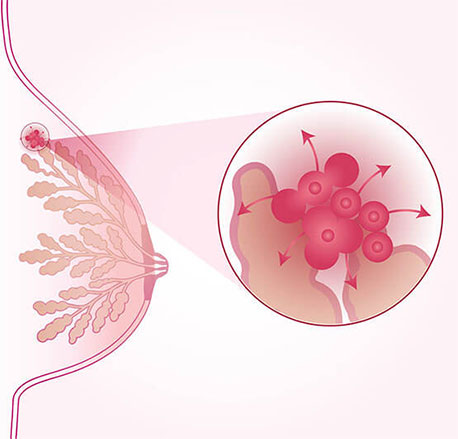
How does cancer spread, or metastasize?
The spread of cancer usually happens through one or more of the following steps:
- Breast cancer is known to metastize through the lymphatic channels
- Migration through circulation - Cancer cells are carried by the lymph system and the bloodstream to other parts of the body.
- Cancer cells lodge in capillaries - Cancer cells stop moving as they are lodged in capillaries at a distant location and divide and migrate into the surrounding tissue.
- Growth of new small tumors - Cancer cells form small tumors at the new location (called micrometastases.)
Symptoms Of Metastatic Breast Cancer?
The symptoms may vary, depending on the part or organ to which breast cancer has spread and what type of tissue the new cancer growth has invaded. All symptoms should be reported to your physician. following aresome symptoms that vary by locations commonly associated with breast cancer metastasis.
Metastasis in the bone may cause:
- Severe, progressive bony pain may indicate spread to the bone
- Bones can get easily fractured or broken due to cancerous growth in the bones
Metastasis to the brain may cause:
- Persistent, progressively worsening headache or pressure to the head
- Vision disturbances
- Seizures
- Vomiting or nausea
- Behavioural changes or personality changes
Metastasis to the liver may cause:
- Jaundice
- Itchy skin or rash
- Abnormally high enzymes in the liver
- Abdominal pain, appetite loss, nausea, and vomiting
Metastasis to the lungs may cause:
- Chronic cough or inability to get a full breath
- Abnormal chest X-ray
- Chest pain
- Other nonspecific systemic symptoms of metastatic breast cancer can include fatigue, weight loss, and poor appetite, but it’s important to remember these can also be caused by medication or depression.
If you notice these symptoms, be sure you talk with your physician. They could be important for getting the treatment you need.


BREAST CANCER DURING PREGNANCY
Can A Woman Get Breast Cancer During Pregnancy?
It is possible to be diagnosed with breast cancer during pregnancy, although it is rare and the breast cancer is not caused by the pregnancy. Women who are diagnosed with breast cancer during pregnancy have tremendous additional strain due to concern for the safety of the unborn child. It can be a traumatic and extremely difficult situation, but there is still hope for both mother and child, thanks to the many treatment options available.
If you are pregnant and have been diagnosed, be sure to communicate carefully with your obstetric care team as well as your oncology team, and it never hurts to verify that they have open communication with each other. Your medical team will take extra care in designing the treatment plan that best controls the breast cancer while protecting your unborn child.
What Cancer Treatments Are Safest During Pregnancy?
Your treatment plan will depend on the size of the tumor, its location, and the term of your pregnancy. As with women who are not pregnant, surgery is usually the first step for treating early-stage breast cancer. Surgery during pregnancy can be safely performed with little risk to your unborn child, so your medical team will most likely proceed by removing the lump with a lumpectomy or mastectomy, and possibly some lymph nodes from the armpit or axilla. Chemotherapy may be a treatment option, depending on your cancer type and the stage of your pregnancy. The effects of hormone therapy on unborn children is not entirely understood. Because of this, if hormone therapy is prescribed, it will most likely be used only after the baby is born. Although the cancer itself cannot spread to and harm the unborn child, sometimes the best treatment plan for the mother may put the unborn child at risk. These decisions will require the expertise and consultation between your obstetrician, surgeon, medical oncologist, and radiation oncologist. You will also need the emotional support of family and friends and may benefit from the professional assistance of a skilled counsellor or psychologist.
Although by far, the most common breast cancer type is ductal carcinoma in situ (DCIS), there are other types that are less commonly seen.
Medullary Carcinoma
- Medullary carcinoma accounts for 3-5% of all breast cancer types. The tumor usually shows up on a mammogram, but does not always feel like a lump. At times, it feels like a spongy change of breast tissue.
Tubular Carcinoma
- Making up about 2% of all breast cancer diagnosis, tubular carcinoma cells have a distinctive tubular structure when viewed under a microscope. It is usually found through a mammogram and is a collection of cells that can feel like a spongy area of breast tissue rather than a lump. Typically this type of breast cancer is found in women aged 50 and above and usually responds well to hormone therapy.
Mucinous Carcinoma (Colloid)
- Mucinous carcinoma represents approximately 1% to 2% of all breast cancers. The main differentiating features are mucus production and cells that are poorly defined. It also has a favorable prognosis in most cases.
Paget Disease Of The Breast Or Nipple
- This condition (also known as mammary Paget disease) is a rare type of cancer affecting the skin of the nipple and often the areola, which is the darker circle of skin around the nipple. Most people with Paget disease evident on the nipple also have one or more tumors inside the same breast; generally either ductal carcinoma in situ or invasive breast cancer (1–3). Paget disease is frequently misdiagnosed at first because the first noticeable symptoms can easily be confused with more common skin conditions affecting the nipple. Like all breast cancers, the prognosis for Paget disease depends on a variety of factors, including the presence or absence of invasive cancer and whether or not it has spread to nearby lymph nodes.